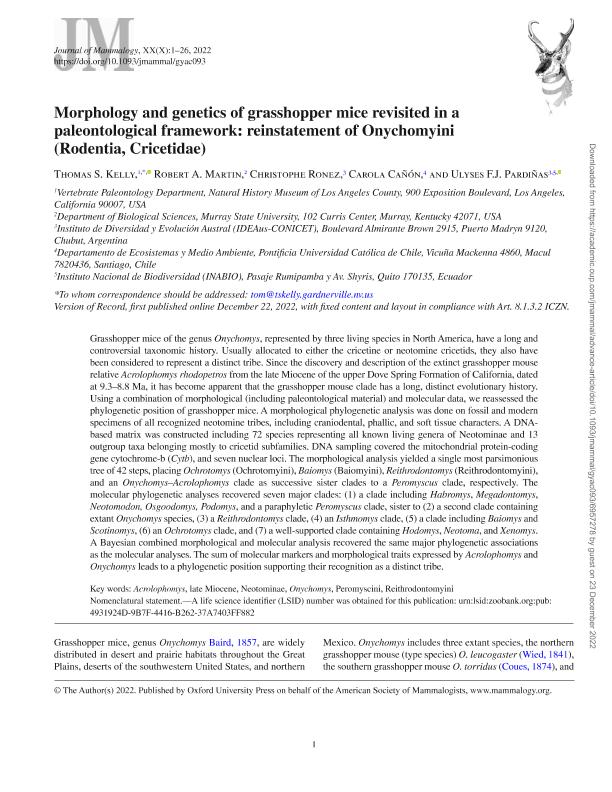Mostrar el registro sencillo del ítem
dc.contributor.author
Kelly, Thomas S.
dc.contributor.author
Martin, Robert A.
dc.contributor.author
Ronez, Christophe

dc.contributor.author
Cañón, Carola
dc.contributor.author
Pardiñas, Ulises Francisco J.

dc.date.available
2024-04-19T11:04:11Z
dc.date.issued
2023-02
dc.identifier.citation
Kelly, Thomas S.; Martin, Robert A.; Ronez, Christophe; Cañón, Carola; Pardiñas, Ulises Francisco J.; Morphology and genetics of grasshopper mice revisited in a paleontological framework: reinstatement of Onychomyini (Rodentia, Cricetidae); Oxford University Press; Journal of Mammalogy; 104; 1; 2-2023; 3-28
dc.identifier.issn
0022-2372
dc.identifier.uri
http://hdl.handle.net/11336/233513
dc.description.abstract
Grasshopper mice of the genus Onychomys, represented by three living species in North America, have a long and controversial taxonomic history. Usually allocated to either the cricetine or neotomine cricetids, they also have been considered to represent a distinct tribe. Since the discovery and description of the extinct grasshopper mouse relative Acrolophomys rhodopetros from the late Miocene of the upper Dove Spring Formation of California, dated at 9.3?8.8 Ma, it has become apparent that the grasshopper mouse clade has a long, distinct evolutionary history. Using a combination of morphological (including paleontological material) and molecular data, we reassessed the phylogenetic position of grasshopper mice. A morphological phylogenetic analysis was done on fossil and modern specimens of all recognized neotomine tribes, including craniodental, phallic, and soft tissue characters. A DNAbased matrix was constructed including 72 species representing all known living genera of Neotominae and 13 outgroup taxa belonging mostly to cricetid subfamilies. DNA sampling covered the mitochondrial protein-coding gene cytochrome-b (Cytb), and seven nuclear loci. The morphological analysis yielded a single most parsimonious tree of 42 steps, placing Ochrotomys (Ochrotomyini), Baiomys (Baiomyini), Reithrodontomys (Reithrodontomyini), and an Onychomys?Acrolophomys clade as successive sister clades to a Peromyscus clade, respectively. The molecular phylogenetic analyses recovered seven major clades: (1) a clade including Habromys, Megadontomys, Neotomodon, Osgoodomys, Podomys, and a paraphyletic Peromyscus clade, sister to (2) a second clade containing extant Onychomys species, (3) a Reithrodontomys clade, (4) an Isthmomys clade, (5) a clade including Baiomys and Scotinomys, (6) an Ochrotomys clade, and (7) a well-supported clade containing Hodomys, Neotoma, and Xenomys. A Bayesian combined morphological and molecular analysis recovered the same major phylogenetic associations as the molecular analyses. The sum of molecular markers and morphological traits expressed by Acrolophomys and Onychomys leads to a phylogenetic position supporting their recognition as a distinct tribe.
dc.format
application/pdf
dc.language.iso
eng
dc.publisher
Oxford University Press

dc.rights
info:eu-repo/semantics/openAccess
dc.rights.uri
https://creativecommons.org/licenses/by-nc-sa/2.5/ar/
dc.subject
Acrolophomys
dc.subject
late Miocene
dc.subject
Neotominae
dc.subject
Onychomys
dc.subject
Peromyscyini
dc.subject
Reithrodontomyini
dc.subject.classification
Otras Ciencias Biológicas

dc.subject.classification
Ciencias Biológicas

dc.subject.classification
CIENCIAS NATURALES Y EXACTAS

dc.subject.classification
Paleontología

dc.subject.classification
Ciencias de la Tierra y relacionadas con el Medio Ambiente

dc.subject.classification
CIENCIAS NATURALES Y EXACTAS

dc.title
Morphology and genetics of grasshopper mice revisited in a paleontological framework: reinstatement of Onychomyini (Rodentia, Cricetidae)
dc.type
info:eu-repo/semantics/article
dc.type
info:ar-repo/semantics/artículo
dc.type
info:eu-repo/semantics/publishedVersion
dc.date.updated
2024-04-17T12:52:20Z
dc.journal.volume
104
dc.journal.number
1
dc.journal.pagination
3-28
dc.journal.pais
Estados Unidos

dc.description.fil
Fil: Kelly, Thomas S.. Natural History Museum Los Angeles County (n.h.museum Los Angeles County);
dc.description.fil
Fil: Martin, Robert A.. Murray State University; Argentina
dc.description.fil
Fil: Ronez, Christophe. Consejo Nacional de Investigaciones Científicas y Técnicas. Centro Científico Tecnológico Conicet - Centro Nacional Patagónico. Instituto de Diversidad y Evolución Austral; Argentina
dc.description.fil
Fil: Cañón, Carola. Pontificia Universidad Católica de Chile; Chile
dc.description.fil
Fil: Pardiñas, Ulises Francisco J.. Consejo Nacional de Investigaciones Científicas y Técnicas. Centro Científico Tecnológico Conicet - Centro Nacional Patagónico. Instituto de Diversidad y Evolución Austral; Argentina
dc.journal.title
Journal of Mammalogy

dc.relation.alternativeid
info:eu-repo/semantics/altIdentifier/url/https://academic.oup.com/jmammal/advance-article/doi/10.1093/jmammal/gyac093/6957278
dc.relation.alternativeid
info:eu-repo/semantics/altIdentifier/doi/http://dx.doi.org/10.1093/jmammal/gyac093
Archivos asociados
